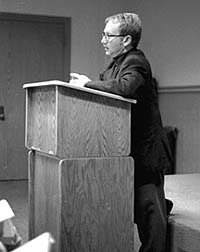








 Society has many ways to recognize and acknowledge art that is present, art that has material substance that can be seen or touched. But how do we begin to appreciate the art of absence, the art of what has disappeared?
Society has many ways to recognize and acknowledge art that is present, art that has material substance that can be seen or touched. But how do we begin to appreciate the art of absence, the art of what has disappeared?
"There was a whole range of Jewish life that became absent. Today I will try to remember for a fleeting moment," said Aron Rodrigue, Associate Professor of Jewish History at Stanford University, in his lecture, The Holocaust: History and Memory. The Annual David Hyman B'nai B'rith Lecture in Judaism was given on April 16, marking Holocaust Memorial Day. Rodrigue himself is a Turkish Jew and thus spoke of what he realized was "a private loss that was part of a much greater public loss."
The idea of private and public loss permeated the lecture. Such a dramatic loss of human life and the outrageous cruelty of its perpetrators is an intensely personal recollection, a grieving that is beyond words. Although this personal loss was evoked in every word of the lecture, Rodrigue spoke directly of what could be put into words, a much more public loss of an entire culture.
This public loss was the loss of a community, its art, its language, the whole of Sephardi (Judeo-Spanish) Jewry. Rodrigue gave an account of history of Jews in Salonica, the Spanish-speaking Jews who were exiled from the Iberian Peninsula in 1492 and resettled in Salonica. They established communities based on what city they had come from in Spain; spoke and wrote in Ladino, which is Spanish written in Hebrew script; published books and newspapers; and on April 9, 1941, the day of German entrance into the region, numbered 56,000. In the short period between January and May of 1943, almost all of these 56,000 were killed and only 1,000 Jews returned to the city after the war.
 Through the articulation of a public loss, each personal loss, each absence was felt. When Rodrigue read a poem written in Ladino, the power of listening to a language that has disappeared, that was wiped out, became a startling reminder of the silence that speaks, of the mute voices of the people who once spoke the language, of the private losses.
Through the articulation of a public loss, each personal loss, each absence was felt. When Rodrigue read a poem written in Ladino, the power of listening to a language that has disappeared, that was wiped out, became a startling reminder of the silence that speaks, of the mute voices of the people who once spoke the language, of the private losses.
Through history, memory speaks. If the poem was nothing more than an historical artifact, what it created was a voice for a voiceless memory. Thus, Rodrigue spoke of historians who find history and memory to be antithetical to one another, who believe history to be "scholarly and theoretical, a process of real reconstruction" and memory, "a perpetual evolution, plural, distinctly generated by different groups." But Rodrigue spoke as a "believer that history and memory need not always be antithetical," and described a historian who could act as "a vector of memory."
Memory is often what is repressed; it is, as Rodrigue said, "structured forgetfulness, the unrecollectable, the un remembered," but it is the task of history to not be forgotten, to not be lost, to be recorded.
Rodrigue spoke "as a historian, but also as one of its descendants." In fact, Rodrigue spoke as a historian in order to be able to speak as one of its descendants. He spoke of history in order to speak of the memory that could not be spoken.
Artitudes is a column for opinions about the arts. Theresa Giron is an Arts editor.
Public and private losses: Aron Rodrigue, Associate Professor of Jewish History at Stanford, speaks on the Holocaust.(photo by Nicole Wright)

Copyright © 1996, The Oberlin Review.
Volume 124, Number 21; April 19, 1996
Contact Review webmaster with suggestions or comments at ocreview@www.oberlin.edu.
Contact Review editorial staff at oreview@oberlin.edu.